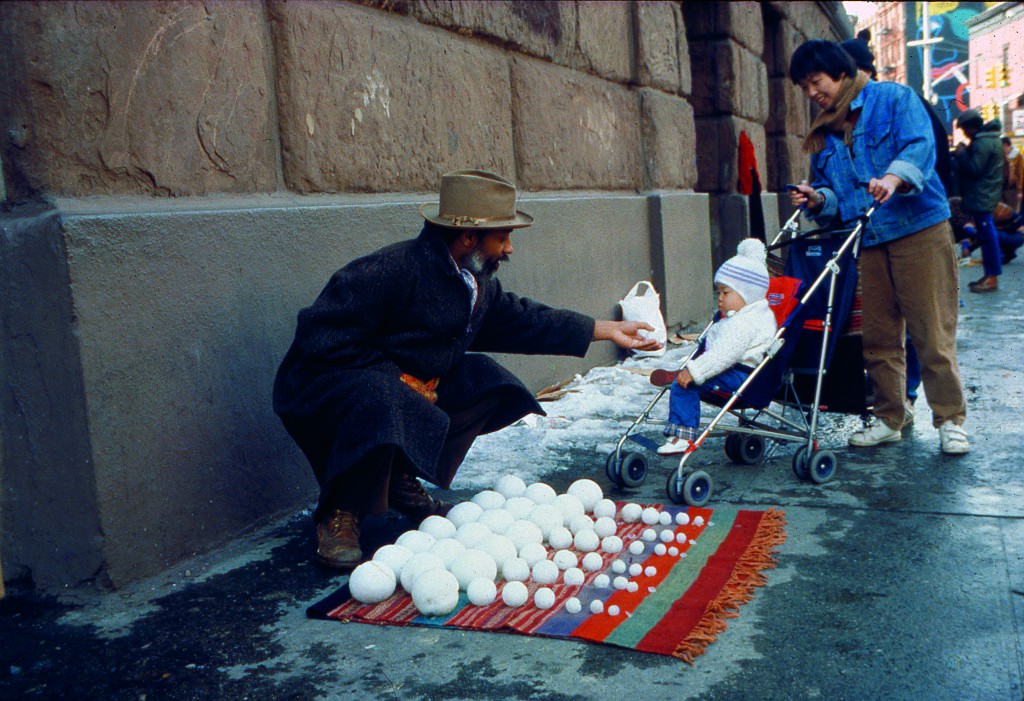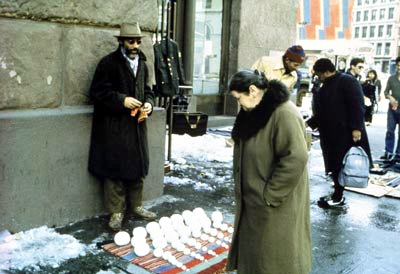Can you remove the rainbow from happening?
David Hammons has been making art and challenging the conditions of artmaking for nearly forty years. 2008 the artist was invited by the nonprofit multidisciplinary arts initiative Alexandria Contemporary Arts Forum to realize a project in Egypt. We are sharing a great text by David Hammons featured in the artforum on the occasion of his work in Alexandria:

The hotel I’m staying in, the Windsor Palace, is about twenty minutes from the gallery. Walking the streets between the gallery and the hotel, I found five separate sites; I was looking for abstract things that normal people don’t look at. I found a wooden chair chained to a pole—I guess some security guards use this chair to sit in. There’s a puddle of water in the street; a piece of cardboard caught on a light fixture, hanging on a wire. There’s an appliance store filled with televisions and refrigerators and stoves—the music was so loud at this place that I decided to call it a sound installation. There’s also a tree painted green. It’s so green I decided to call it the Pink Tree. The sixth site was Sight Unseen—I leave the audience to find their own.
At first, the sites were further stretched out, but there’s no way people could have gone to see them all. So I narrowed it down to sites between the hotel and the gallery. I only had forty-eight hours in which to do it, and this factor helped to quicken the pace. I had to think spontaneously as opposed to intellectually. It’s like being on a boat that’s going down—you just grab on to whatever’s at hand to stay afloat. There wasn’t time to overthink anything.
I had to explain that it wasn’t going to be in their gallery. They had hoped it would be—it’s a very nice space, a marvelous, beautiful restoration of an apartment. As beautiful as the space was, that was too easy to do. I don’t particularly care for galleries. I’d rather walk through the city and find my own spaces.
I do that a lot in New York. I’ll find something and call people up with the address and tell people to go look at it. It could be a stack of wood in the subway or something that looks like a Joseph Beuys or something lying around.
We made a little sketch of each piece with the address and the title. The gallery director said that if there wasn’t a visual clue, then the people wouldn’t even go to look for them. I don’t really care much if they go to see them. The concept is more interesting than the actual objects, because the concept is invisible while the objects are visible. Except for the sixth site—there they have to use the mind’s eye.
The adventure of coming here is more important to me than the exhibition—to get to faraway places is more exciting than to do something in a normal space. Have you heard of the White Night in Paris? It is cosponsored by Fondation Cartier and the City of Paris. I think it’s been going on for some time. Each year, they invite thirteen artists to do installations around the city, and everyone stays up from 7 PM to 7 AM. I was invited to participate this year. For my piece, I predicted that a double rainbow would appear over the city at night on the fourth of October. Actually, I saw a double rainbow about just two days before I met with representatives from the Fondation Cartier and the City of Paris about the project. Both agreed, but then approximately three days beforehand, the City of Paris removed my name from the exhibition. I think they canceled it because they couldn’t explain it to anyone. But how do you stop or remove the rainbow from happening?
I choose artworks that are ephemeral because, well, life is that. It’s such a temporary journey.
David Hammons
In the famed performance Bliz-aard Ball Sale (1984), documentation of which is on view at both the Studio Museum and the Grey Art Gallery, New York City, Hammons stood on the street alongside other vendors on Cooper Square, selling snowballs in different sizes (from XS to XL) to passersby. By assigning value and appearing to seek profit from a commonplace, short-lived object, Hammons draws attention to both the arbitrary nature of the art market and the precarious financial conditions of many working-class New Yorkers.

David Hammons performing Bliz-aard Ball Sale, 1983, Cooper Square, New York. Courtesy Tilton Gallery, New York. Photo by Dawoud Bey

